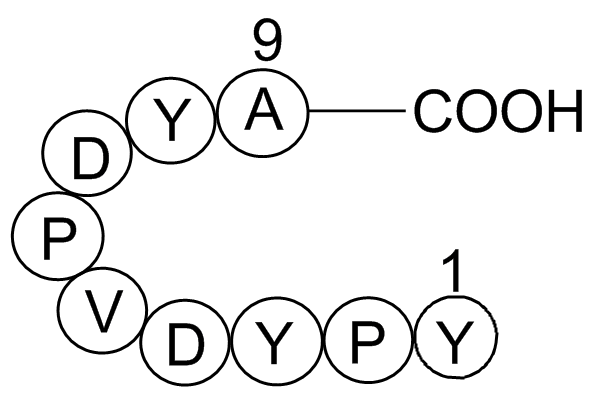Influenza Hemagglutinin (HA) Peptide (Synonyms: H-Tyr-Pro-Tyr-Asp-Val-Pro-Asp-Tyr-Ala-OH) |
| Catalog No.GP10152 |
A peptide
Products are for research use only. Not for human use. We do not sell to patients.

Cas No.: 92000-76-5
Sample solution is provided at 25 µL, 10mM.
HA tag,Complexes containing plasmid DNA, transferrin-polylysine conjugates, and polylysine-conjugated peptides derived from the N-terminal sequence of the influenza virus hemagglutinin subunit HA-2 have been used for the transfer of luciferase or -galactosidase marker genes to K562 cells, HeLa cells, and BNL CL.2 hepatocytes. The presence of these influenza peptide conjugates in the DNA complexes renders the complexes active in membrane disruption in a liposome leakage assay and results in a substantial augmentation of the transferrin-polylysine-mediated gene transfer.
Fusogenic peptides derived from the N-terminal sequence of the influenza virus hemagglutinin subunit HA-2 is part of the DNA complexes and the resulting augmentation of gene transfer to cultured cells1.
In the influenza virus, the hemagglutinin (HA) protein mediates both binding of the virus to the cell surface and the subsequent fusion of viral and cellular membranes. HA is composed of a receptor-binding subunit, denoted HA1, and a fusogenic subunit, denoted HA2. The native HA1yHA2 complex, as found on the surface of the native virus, is fusioninactive. For influenza virus, membrane fusion is regulated by the conformational state of the hemagglutinin (HA) protein, which switches from a native (nonfusogenic) structure to a fusion-active (fusogenic) conformation when exposed to the acidic environment of the cellular endosome. The native structure of HA is trapped in a metastable state and that the fusogenic conformation is released by destabilization of native structure2.
References:
1. E. WAGNER, C. PLANK et al, Influenza virus hemagglutinin HA-2 N-terminal fusogenic peptides augment gene transfer by transferrin-polylysine-DNA complexes: Toward a synthetic virus-like gene-transfer vehicle. Proc. Nati. Acad. Sci. USA Vol. 89, pp. 7934-7938, September 1992
2. C. M. CARR, C. CHAUDHRY, P. S. KIM et al. Influenza hemagglutinin is spring-loaded by a metastable native conformation. Proc. Natl. Acad. Sci. USA Vol. 94, pp. 14306–14313
Average Rating: 5 (Based on Reviews and 30 reference(s) in Google Scholar.)
GLPBIO products are for RESEARCH USE ONLY. Please make sure your review or question is research based.
Required fields are marked with *




